Advanced SIMPLIS Training
|
To download the examples for Module 5, click Module_5_Examples.zip
In this Topic Hide
There are several ways to pass parameters into subcircuits. In the previous topic, 5.0 About Parameters, you used the .GLOBALVAR statement to define a global parameter. A drawback to global parameters is that every instance uses the same parameter value. In this topic, you will learn how to pass parameters through the symbol-to-subcircuit interface, which allows you to pass the same parameter name with different values for each instance.
In this exercise, you will learn how to do the following:
The schematic component param_rc.sxcmp used in this exercise requires a single parameter, with the parameter name FC. This parameter will set the filter's -3dB cutoff frequency. The example schematics are already prepared and ready to run, only the parameter passing part is missing.
The PARAMS symbol property is a special property which the netlister detects and uses to add parameters to the netlist instantiation line for the symbol. In this exercise you will add the PARAMS property to the param_rc.sxcmp symbol.
To add the PARAMS symbol property to the FC parameter, follow these steps:
Open the schematic, 5.2_parametrized_rc_filters.sxsch.
To add the PARAMS property to the param_rc.sxcmp symbol with a value of FC=10k, follow these steps:
Select U1, and then
type the keyboard shortcut Shift+S
to open the symbol.
Result: The param_rc schematic component symbol opens in the symbol
editor.
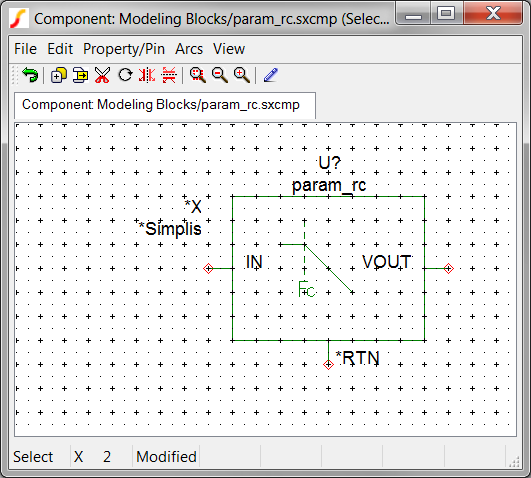
From the Symbol Editor menu, select Property/Pin
Add Property...
Result: The Add Property dialog opens.
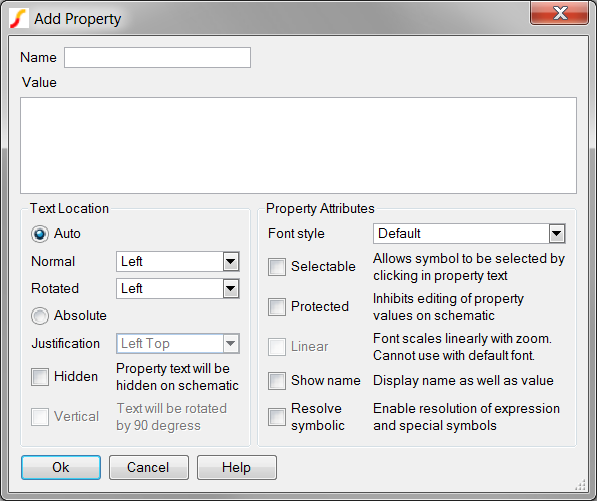
In the Name field, type PARAMS.
In the Value field, type FC=10k.
Check the Selectable
and Show name check boxes.
Result: The configured Add Property
dialog should appear as below:
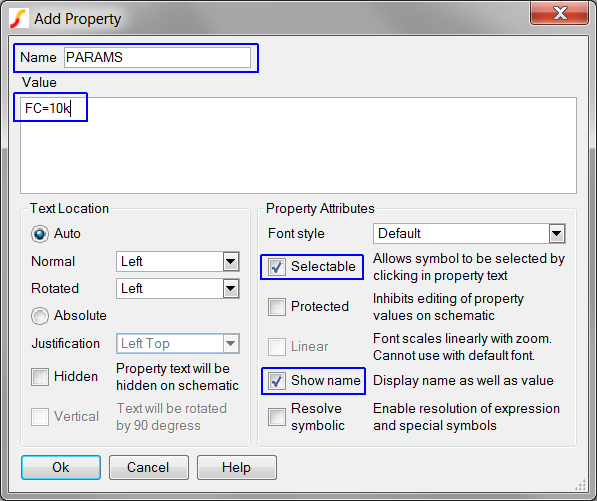
Click Ok on the
Add Property Dialog.
Result: The PARAMS property is added on the left side of the symbol with the
value FC=10k.

From the Symbol Editor menu, select File Save...
Click Ok on the Save Symbol dialog to save the symbol to the component file, and then close the Symbol Editor window.
To update the instantiated symbols on the schematic, follow these steps:
Select U1.
Press and hold the Ctrl
key while selecting U2.
Result: Both symbols for U1 and U2
are selected:
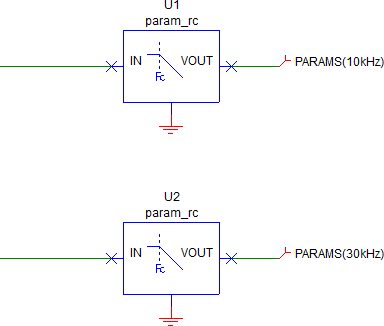
Right click to bring up the context menu, and then select
Restore Properties...
Result: A dialog opens for you to confirm
that you want to add the new properties to the instantiated symbols:
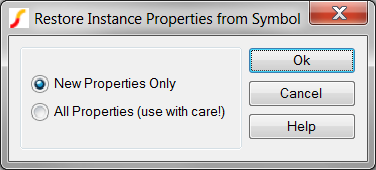
Click Ok.
Result: The schematic instances for
U1 and U2 are updated with the new symbol property PARAMS:
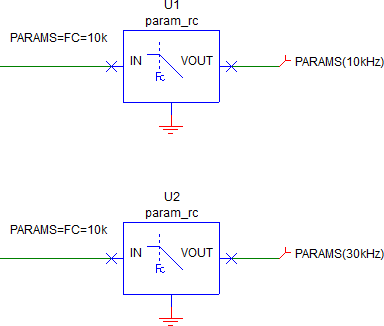
Press F9 to run the
simulation.
Result: The design simulates in SIMPLIS
and two gain curves are output, one for each of the two filters. The
pole frequency is 10kHz for both filters because the passed parameters
are identical for both U1 and U2.
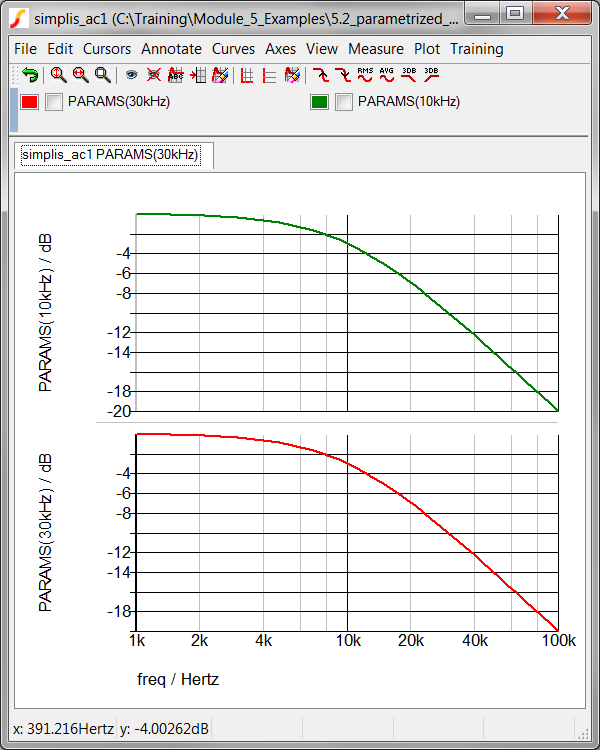
In Exercise #1, you added a symbol property PARAMS to the symbol stored in the schematic component file. The PARAMS property is a special symbol property and the netlister handles this property differently than the other properties. When the symbol template is resolved and the netlist entry is made, the value of the PARAMS property (in this case, FC=10k) is added to the instantiation line for the symbol after the vars: keyword. In the next exercise you will examine how the PARAMS value can be different on each instantiated symbol and how the resulting netlist entry and simulation results are affected.
In this section, you will change the value of PARAMS property and look at how the netlist and the simulation results change.
To edit the property PARAMS value on the U2 instantiated symbol, follow these steps:
Double click on the PARAMS property on the left side of the
U2 symbol.
Result: The Edit Property dialog opens.
Change the Value to FC=30k.
Click Ok.
Press F9 to run the
simulation.
Result: The simulation executes and a new
set of curves are overlaid on the first set. The pole frequency for
the filter U2 is now 30kHz. The filter U1 has the same 10kHz pole
frequency.

You have now edited the local, instantiated value of the PARAMS property on one of the rc_filter.sxcmp schematic components. This edit passes 30kHz as the pole frequency parameter into the subcircuit for the U2 instantiation. In the next exercise, you will see how the netlist is affected by this change.
From the SIMetrix/SIMPLIS command shell menu, select Edit
Netlist (before preprocess).
Result: The netlist opens in Notepad++.
Scroll down to line 23, where the instantiation line U1 is located.

The key concept here is that a single parameter can passed into the subcircuit on the netlist instantiation line. Multiple instantiations can use the same subcircuit (param_rc) with different parameter values. This allows a single schematic model to be configured with the passed parameter value.
The param_rc schematic component file uses three parameters:
Two parameters are defined with .GLOBALVAR statements in the command window of the parent schematic.
The other parameter is passed through the symbol-to-subcircuit interface using the PARAMS property.
You can pass multiple parameters using the PARAMS symbol property, and in the next exercise you will add the two global parameters to the PARAMS property.
To open the symbol for the schematic component param_rc.sxcmp and add the two global parameters, follow these steps:
Select U1, and
then type the keyboard
shortcut Shift+S to
open the symbol.
Result: The param_rc schematic component symbol opens in the Symbol Editor.
Click on the PARAMS
property.
Result: The PARAMS property changes from
black to blue, indicating the property is selected.
Press F7 to edit the PARAMS property.
In the Value field, after the FC=10k, add R_VAR=1k GAIN=1.
Note: There are spaces between each property name-value pair.
Result: The final property should appear
as follows:
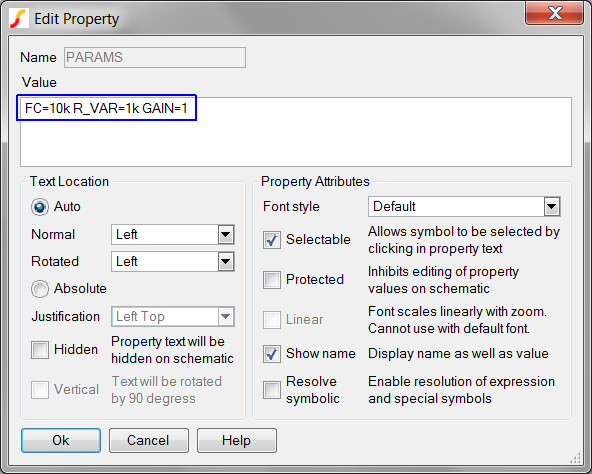
Click Ok.
From the Symbol Editor menu, select File Save...
Click Ok on the Save Symbol dialog to save the symbol to the component file, and then close the Symbol Editor window.
To update the instantiated symbols on the schematic, follow these steps:
Select U1, and then
hold down the Ctrl key
while selecting U2.
Result: Both symbols for U1 and U2
are selected:

Right click to bring up the context menu, and select Restore Properties...
Result: The same dialog seen in Exercise
#1 opens, asking you to confirm the action.
Select the All Properties
(use with care!) radio button.
IMPORTANT: Because the PARAMS property already
exists, you need to select the All
Properties (use with care!)
radio button in order to revert the symbol to the version stored
in the .sxcmp file. In the process, this overwrites the FC=30k
parameter name-value pair set in Exercise #2.
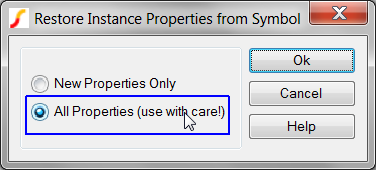
Click Ok.
Result: The schematic instances for
U1 and U2 are reverted to the symbol saved to the schematic component
file.
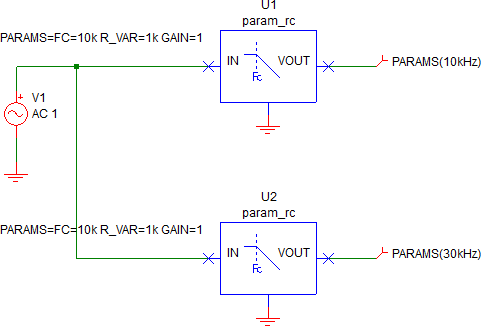
Press F9 to run the
simulation.
Result: The design fails to simulate, and
the netlist preprocessor outputs four errors to the SIMetrix/SIMPLIS
command shell window:
These errors tell you that once a parameter name is defined to be global, the name is reserved and cannot be used as a local parameter name. When you added model parameter names to the PARAMS property, you defined parameters local to the param_rc.sxcmp schematic component. These errors protect you from simulating a design with two different parameter values, one global and one local.
To correct these errors, you need to comment out the .GLOBALVAR parameters and change the value of the FC parameter for U2 to 30k. To make these changes, follow these steps:
On the 5.2_parametrized_rc_filters.sxsch schematic, press F11 to open the command (F11) window.
Comment out the two remaining .GLOBALVAR statements.
Result: The three .GLOBALVAR statements
are commented out:
Double click on the PARAMS property for U2.
Change the PARAMS property value to FC=30k R_VAR=1k GAIN=1.
Close the graph window.
Press F9 to run the
simulation.
Result: The simulation executes as expected.
The pole frequency of the filter U2 is 30kHz.
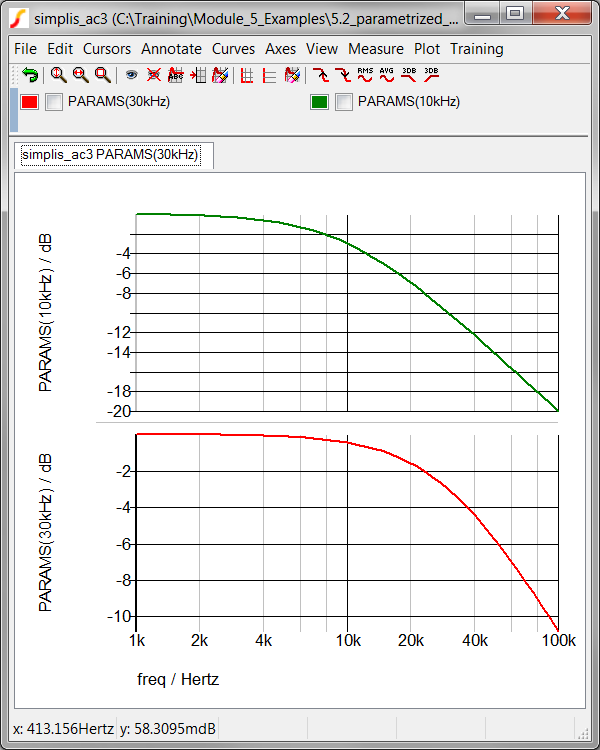
From the SIMetrix/SIMPLIS command shell menu, select Edit
Netlist (before preprocess).
Result: The netlist opens in Notepad++.
Scroll down to line 23, where the instantiation line U1 is located.

Note: The vars: keyword and the FC=10k R_VAR=1k GAIN=1 parameter string are being passed to the first subcircuit. The second instantiation, for U2 is being passed the FC=30k R_VAR=1k GAIN=1 parameter string. these parameters configure the values in the param_rc subcircuit.
The key concept here is that multiple parameters can be passed on the netlist instantiation line. Individual instantiations can use the same subcircuit (param_rc) with different parameter values. This allows a single subcircuit model to be used in multiple instantiations where each instantiation can be configured with different parameter values.
The PARAMS property is a special symbol property built-into SIMetrix/SIMPLIS. The netlister reads the property value and concatenates the netlist instantiation line with the PARAMS property value preceded with a vars: keyword. This effectively passes the parameter string into the instantiation as a set of parameters.
A parameter string is an array of parameter name-value pairs, such as FC=30k R_VAR=1k GAIN=1. Parameter strings are used extensively in SIMetrix/SIMPLIS.
The PARAMS property is easy to add to a symbol and offers a quick way to parameterize a subcircuit. That said, none of the built-in symbols use the PARAMS property to pass parameters to the underlying subcircuit. It is primarily used to temporarily pass parameters through the symbol-to-subcircuit interface.
The recommended way to pass parameters is described in the 5.1 Passing Parameters into Subcircuits Using the SIMPLIS_TEMPLATE Property topic.
At the end of the module, please fill out the Module # 5 Evaluation form at surveymonkey.com.
© 2015 simplistechnologies.com | All Rights Reserved